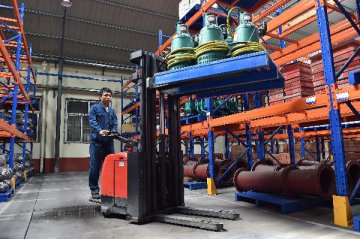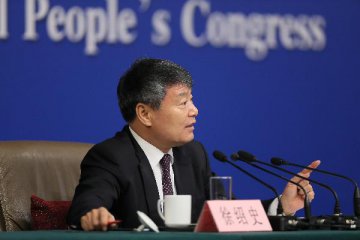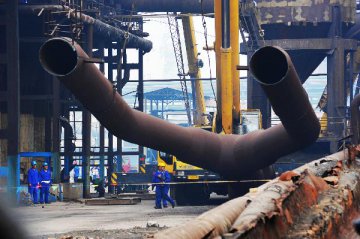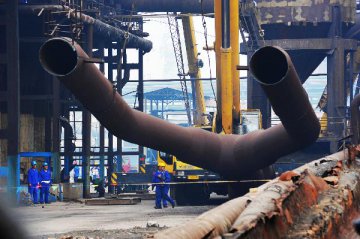
2017 is a key year to deepen supply-side structural reform and cut overcapacity. The task is still tough due to many new problems, risks and challenges. How is the task of cutting overcapacity, destocking and deleveraging gong on by July and what are challenges in the second half of this year?
Focus will be put on cutting overcapacity of “zombie enterprises”
Now half of 2017 has passed. As of the end of May, 42.39 million tons of crude steel capacity and 97 million tons of coal capacity had been cut, accounting for 84.8 percent and 65 percent of the annual goals respectively, said the National Development and Reform Commission (NDRC). Seen from the statistics, the progress of cutting overcapacity has beaten expectation.
An analyst at www.315i.com said in an interview of Securities Daily on July 10 that based on current pace, the low target of cutting overcapacity has been over-fulfilled and it won’t be too difficult to achieve the high target. Although debts resulting from closing down enterprises which produce steel products made of scrap steel need to be tackled, data targets have been completed, marking an end of governing the above-said enterprises.
The fulfillment of task of reducing coal capacity has outpaced expectation in terms of no matter quantity or quality, said Peng Xin, analyst of coal industry with TF Securities. In terms of quantity, only 29 percent of the annual target was achieved in the first half of last year, while the figure reached 65 percent in the first five months of this year. In terms of quality, the coal enterprises which were involved in the task of cutting overcapacity last year had halted production or partially suspended production, while the coverage is larger this year.
Peng said that the essential problem of reducing overcapacity is propelling transformation and upgrading. The NDRC and other commissions have been promoting the replacement of coal capacity. They will still focus on cutting overcapacity of small- and medium-sized coal mining enterprises and “zombie enterprises” with poor profitability, productivity and safety.
Tier-3 & tier-4 cities play important role in destocking in real estate sector
Housing inventories in some hot cities fell in the first six months of this year. When housing market in tier-1 and tier-2 cities cooled down thanks to policy adjustment, tier-3 and tier-4 cities play important roles in reducing housing inventories.
Yesterday, Zhang Dawei, chief analyst from Centaline Property, remarked that destocking in housing industry was accelerating across the country in recent months as tier-3 and tier-4 cities were quite active, most of which saw rapid development in destocking in the second quarter.
Zhang added that it is still a difficulty to lower housing inventories in tier-3 and tier-4 cities and the momentum may last till the third and the fourth quarters in view of the enforcement and current market situation.
Relevant officials believed there are several measures of reducing housing inventories in tier-3 and tier-4 cities. First of all, they can try to turn commercial real estate into residential real estate to effectively reduce inventories of the former. Secondly, monetary housing compensation should be adopted to boost housing destocking. Thirdly, they can change some inventories into indemnificatory housing and low-rent houses to help urban low-income groups.
Zhang said that it is less difficult to reduce housing inventories this year on the whole and predicted that effect of reducing housing inventories will be seen in tier-3 and tier-4 cities by the end of the year.
Debt-to-equity swap helps deleveraging
The development of deleveraging, one of the important tasks at present, draws attention from the market. According to statistics released by the National Bureau of Statistics on June 27, debt-to-asset ratio of industrial enterprises above designated size recorded 56.1 percent in May, an decrease of 0.7 percentage points year on year and 0.1 percentage point from a month earlier; while that of state-owned industrial enterprises posted 61.3 percent, which declined by 0.5 percentage points from a year earlier but climbed by 0.1 percentage point when compared with that in April, hiking for the second month since April.
Leverage ratio of Chinese non-financial enterprises kept dropping since the third quarter of last year, said Zhao Yayun, a researcher with Housheng Think Tank told the reporter of Securities Daily yesterday. Debt-to-asset ratio of industrial enterprises above designated size is not high now. Though leverage ratio of state-owned enterprises continues to increase, it will move down quickly by stripping bad assets off via debt-to-equity swap.
Occupation and utilization of capitals of debt-to-equity swap, an issue which needs to be solved, is key to whether this round of market-based debt-to-equity swap can be promoted smoothly, Wang Gang, deputy head with financial research institute of Development Research Center of the State Council, stated in an article on July 6.
Wang suggested that on the one hand, China’s Banking Regulatory Commission (CBRC) should study calculation of risk rated ratio of debt-to-equity swap according to international standard, revise the existing Capital Management Measure, lower the risk rated ratio of banks which hold stocks of industrial and commercial enterprises, and relax restrictions over debt being paid by stocks. On the other hand, the CBRC should take the lead in solving the problem of one enterprise with various debts, and tackle problems together with creditors of banks and non-banks. Meanwhile, it should consider allowing banks to join in making big decisions about operation and management of enterprises involved in debt-to-equity swap, help enterprises improve business ability and protect investment interests of banks.
Translated by Vanessa Chen
























Latest comments